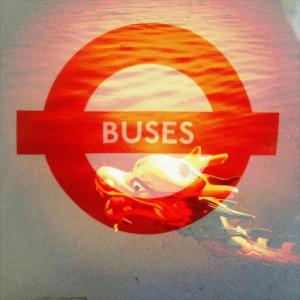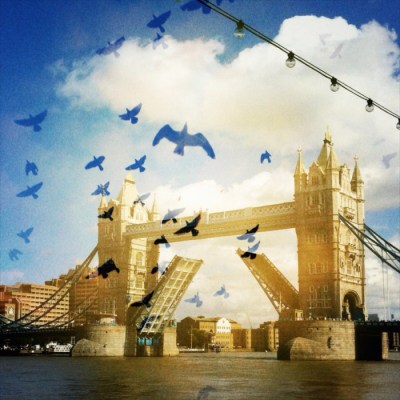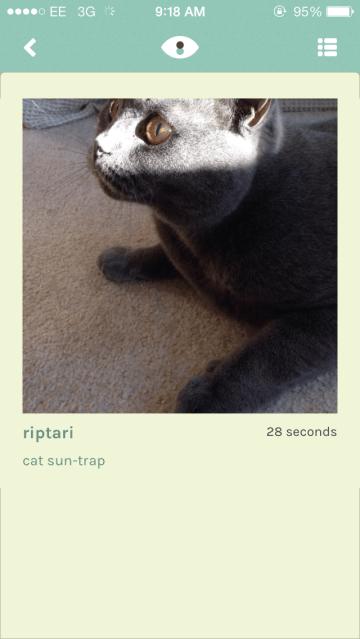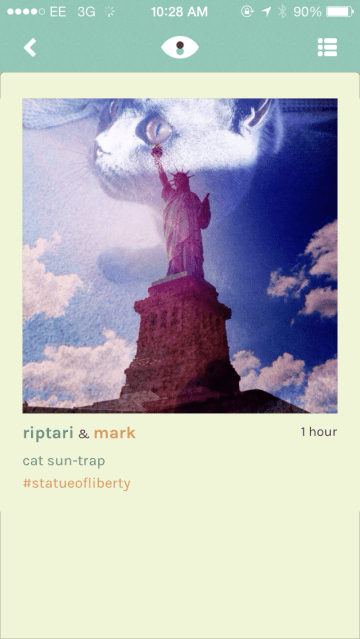Photo-sharing has a new contender for your eyeballs. Meet Dubble: an app for iOS 7 made by a U.K. startup that lets you spice up your selfies by randomly pairing them with a photo taken by someone else. The app digitally combines two separate shots into one by overlaying them over each other. The result mimics the double exposure effect that’s possible on film photography (i.e. when you shoot a roll, and then rewind it and shoot over it a second time — overlaying a second exposure over the first).
Adam Scott, co-founder and CEO, of Dubble (and also the ex-MD of Lomography UK), which has just launched its free-to-download app on iOS, explained how he came up with the concept for the app.
“I come from quite a strong photographic background, and I’ve always been really passionate about film photography. There’s still a massive quality on film that you can’t really get on digital… and one of the things I really like about film is this unexpected feeling you get from getting your films developed, or taking a Polaroid and waiting for that to develop over time,” he told TechCrunch.
“To take that kind of feeling to the next level is double exposures. They’re super unpredictable, and random. And impossible to plan. And one of these other features within the film community is where people do doubles — where you shoot a roll of 35mm film, rewind it and send it to someone to shoot over. And then you get this kind of interaction with someone… I really loved this kind of movement. And it’s something I wanted to bring to the smartphone.”
Here’s a single shot I took with the Dubble app:
And here’s the same shot — remixed a few second later — as a Dubble:
Dubble joins the ranks of photo-sharing apps with a twist that have been emerging in recent times — very recently in the case of Frontback, the app that lets people combine two shots (one from front and rear cameras) into a collage that has more context than a single shot.
Another example of this sort of ‘photo-sharing+’ movement is Rando, which like Dubble, involves randomising the sharing process — allowing users to randomly share a photo they’ve just taken with another user, and get a random shot back in return.
There’s also Seene, which launched earlier this month, and uses computer vision tech to turn a static 2D photo into subtly 3D scene.
Apps that remix the photo-sharing process are both looking to piggyback on the huge popularity of taking and sharing cameraphone snaps, while also seeking to catch users’ attention by doing things a bit differently. Being a bit more creative than just offering Instagram-style filters is essential to stand out in such a well trodden space.
Competing directly with photo-sharing behemoth Instagram is not, in any case, Dubble’s aim, says Scott. And he agrees Dubble is likely to appeal to a less mainstream user-base than Instagram — since results are necessarily so hit and miss.
He argues the two photo-focused apps are approaching photo-sharing from different angles, with Instagram being more “selfish”, as he puts it — in terms of being about sharing your own photos and selfies, and trying to harvest likes and comments on those shots — whereas Dubble is about taking a photo and then giving away sole ownership of it in order to create something new with another person.
Dubble’s interface shows both your singles (i.e. the original shots you took) and the remixed Dubbles — so you do get to keep the original shot, while also getting a second double exposure to boot. You can also see who took the other shot that ended up being remixed with yours.
The Dubble shot includes both people’s descriptions of their original photos, assuming both people wrote a description. “When you click on a photo you see the two stories for the double exposure,” says Scott. “You get these great accidents or random experiences.”
The app also keeps a running list of all your Dubblers (i.e. the other users whose photos yours have been paired with). And in future will include a messaging feature so you’ll be able to chat with others in the community.
While photo apps are ten-a-penny, Scott argues that people are using different photo-sharing apps and services for different reasons — Flickr as a backup service, say, vs Instagram as a self-expression stream, for instance — leaving space for new ones come in if they’re offering something different.
“We’re not competing with anyone. Flickr, Instagram or any of the other photo apps. Ideally we want to be a platform for them, or they could be a platform for us — so you could share to Dubble from Instagram. That would be the ultimate. Or you could share from Flickr to your Dubble profile and Dubble your photos from your Flickr stream,” he says.
“I’d love to collaborate with these people. And definitely not try to compete with how many users they have. Or how many community members they have. I think we’ll have a completely different community to anyone.”
 Dubble has built its app with funding from friends and family, to the tune of around £100K so far — hence prioritising its app as iOS 7-only for now. An Android app is also in development.
Dubble has built its app with funding from friends and family, to the tune of around £100K so far — hence prioritising its app as iOS 7-only for now. An Android app is also in development.
What’s the business model for a community focused on creating digital double exposures? Scott says they’re still “umming and ahhing” over exactly which revenue stream options to chase in future — with the priority for now on “building up a strong creative community”, and pushing out a roadmap of new features over the next 12 to 18 months.
Likely options for money-making down the line include adding in-app purchases for certain features. Dubble is also looking seriously at print as a possible revenue stream — by adding the option to print a Dubble straight from a stream (as a circa 30cm x 30cm print) that users can put on their wall at home. Other revenue models could include opening a shop for photography-related accessories for smartphones and looking into affiliate programs, says Scott.
“Our main focus right now is going to launch. We’ve got seed funding that can see us through til April and then we need to be well on the way of looking at revenue streams, if not quite heavy funding to keep us going,” he adds.


